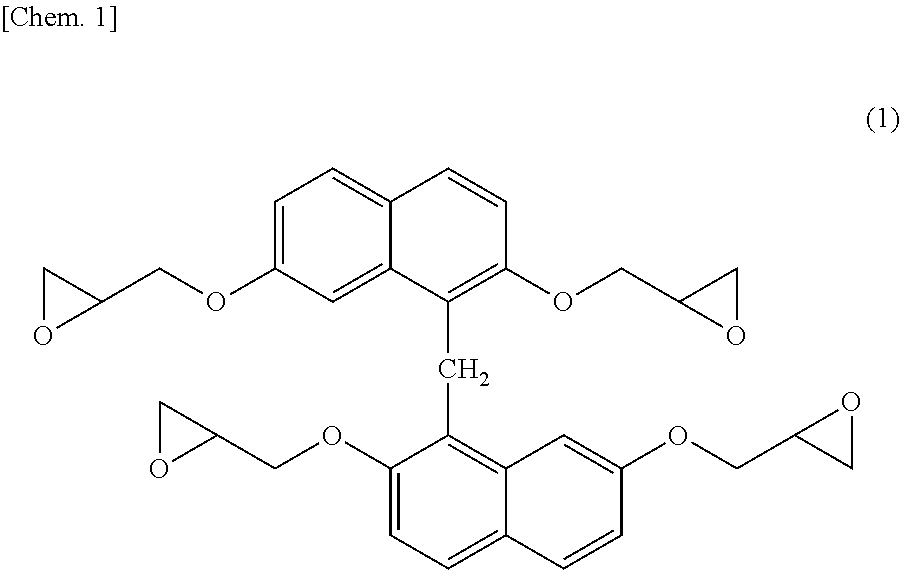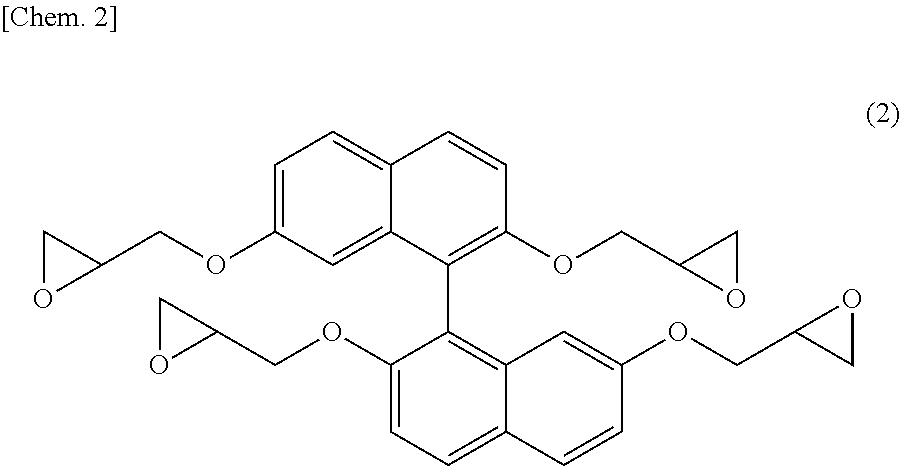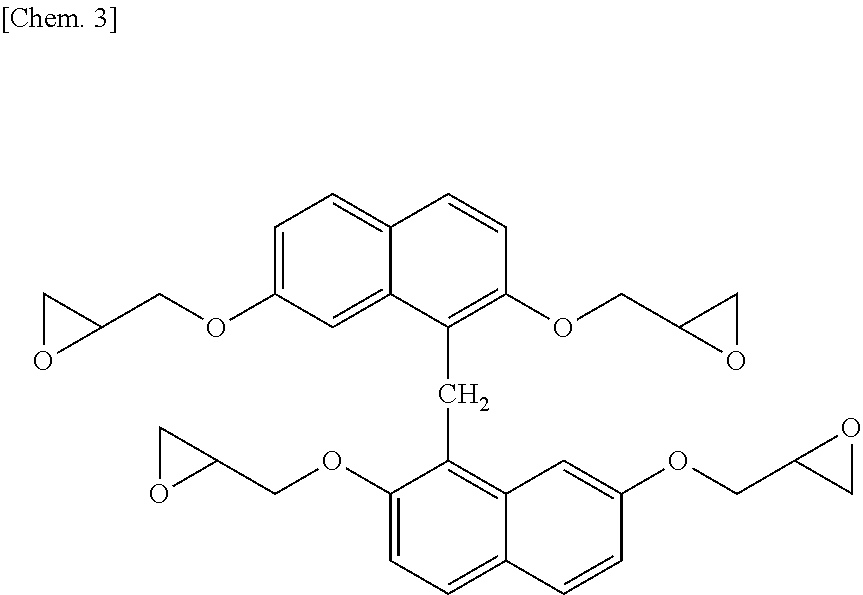Epoxy resin composition, cured product, heat radiating material, and electronic member
a technology of epoxy resin and cured products, applied in the direction of non-macromolecular adhesive additives, adhesive types, chemistry apparatus and processes, etc., can solve the problems of insufficient characteristics of cured products, and achieve excellent heat resistance, low moisture absorption, and low thermal expansibility.
- Summary
- Abstract
- Description
- Claims
- Application Information
AI Technical Summary
Benefits of technology
Problems solved by technology
Method used
Image
Examples
synthesis example 1
[0152]In a flask provided with a thermometer, a stirrer, and a reflux condenser, 139 g (0.5 mole) of iron(III) chloride hexahydrate and 1330 mL of water were charged under nitrogen gas purging, the inside of the reactor was replaced with nitrogen under stirring, and then a solution prepared by dissolving 82 g (0.5 mole) of naphthalene-2,7-dool in 190 mL of isopropyl alcohol was added to the resultant mixture and stirred at 40° C. for 30 minutes. Then, a mixed solution of 139 g (0.5 mole) of iron(III) chloride hexahydrate, 664 mL of water, and 94 mL of isopropyl alcohol was added and heated to 40° C., followed by further stirring for 1 hour. Then, 500 mL of ethyl acetate was added to the reaction solution and stirred for 10 minutes. The reaction solution transferred to a separating funnel, an organic layer was separated, and then further an aqueous layer was extracted with ethyl acetate. The combined organic layer was washed with saturated brine. The solvent was distilled off to leav...
synthesis example 2
[0153]In a flask provided with a thermometer, a dropping funnel, a condenser, and a stirrer, 79.5 g (0.25 moles) of 1,1′-binaphthalene-2,2′,7,7′-tetraol produced in Synthesis Example 1, 462 g (5.0 moles) of epichlorohydrin, and 126 g of n-butanol were charged and dissolved under nitrogen gas purging. The resultant solution was heated to 40° C., and then 100 g (1.20 moles) of a 48% aqueous sodium hydroxide solution was added over 8 hours, and the resultant mixture was further heated to 50° C., followed by further reaction for 1 hour. After the completion of reaction, 150 g of water was added, and a lower layer was discarded after still standing. Then, unreacted epichlorohydrin was distilled off at 150° C. under reduced pressure. The resultant crude epoxy resin was dissolved in 230 g of methyl ethyl isobutyl ketone added thereto. Further, 100 g of a 10 mass % aqueous sodium hydroxide solution was added to the resultant solution, reaction was performed at 80° C. for 2 hours, and then w...
reference example 1 and reference example 2
[0154]Each of the epoxy resin (A-1) of the present invention produced in Synthesis Example 2 and comparative epoxy resin (A-2) represented by [structural formula below]
[0155]
which was a tetrafunctional naphthalene-based epoxy resin (“Epiclon HP-4700” manufactured by DIC Corporation, softening point: 91° C., melt viscosity at 150° C.: 4.5 ps, epoxy equivalent: 166 g / equivalent)],
a phenol novolac phenol resin (“Phenolite TD-2131” manufactured by DIC Corporation, hydroxyl equivalent: 104 g / equivalent) as a curing agent, and triphenylphosphine (TPP) as a curing accelerator were mixed to have a composition shown in Table 1, and the mixture was poured into a mold frame of 11 cm×9 cm×2.4 mm and molded at a temperature of 150° C. for 10 minutes by using a press, and then a molded product was removed from the mold frame. Then, the molded product was cured at a temperature of 175° C. for 5 hours to form a cured product, which was then evaluated for heat resistance, coefficient of linear therm...
PUM
| Property | Measurement | Unit |
|---|---|---|
| thermal conductivity | aaaaa | aaaaa |
| temperature | aaaaa | aaaaa |
| particle diameter | aaaaa | aaaaa |
Abstract
Description
Claims
Application Information
 Login to View More
Login to View More - R&D
- Intellectual Property
- Life Sciences
- Materials
- Tech Scout
- Unparalleled Data Quality
- Higher Quality Content
- 60% Fewer Hallucinations
Browse by: Latest US Patents, China's latest patents, Technical Efficacy Thesaurus, Application Domain, Technology Topic, Popular Technical Reports.
© 2025 PatSnap. All rights reserved.Legal|Privacy policy|Modern Slavery Act Transparency Statement|Sitemap|About US| Contact US: help@patsnap.com



